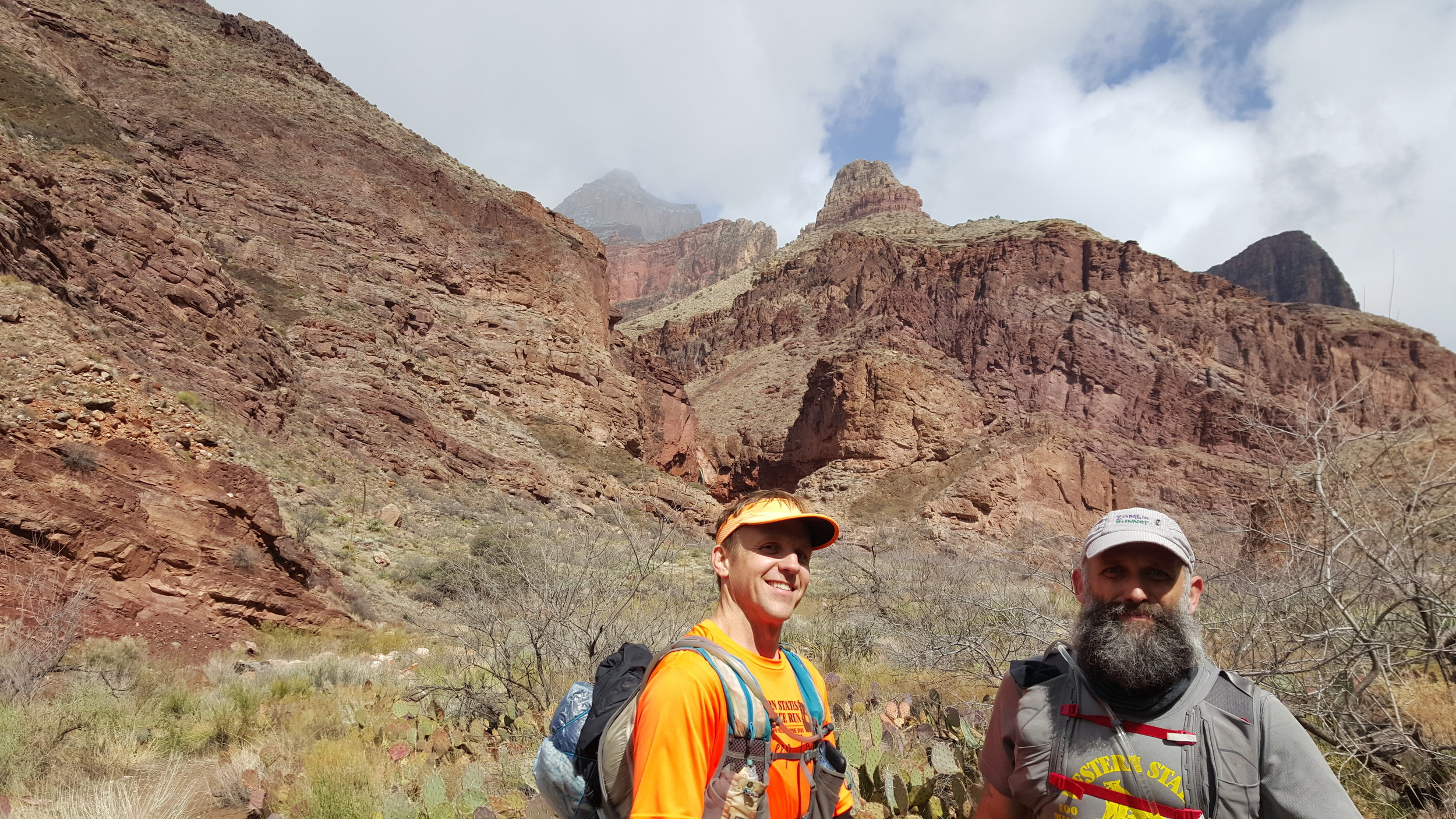The Grand Canyon R2R2R (or R3) is a bucket list run for most trail runners. The idea is to start at one rim, run across the canyon to the other rim and then to run back without camping. The milage, however you do it, is around 50 miles. The effort required is much greater than the milage would indicate. Our group of runners can usually finish a 50 mile trail run in 10 or less hours. We expected to spend around 12 or 15 hours completing the R2R2R. It took us 17.5 hours.
So, what happened? Weather.
Our rental car at the Bright Angel Trailhead
It's a little hard to tell from the picture, but with headlamps glaring off the falling snow, visibility was only a few feet. The temperature was in the mid 20's Fahrenheit.
Bright Angel Trail
We picked one of the last heavy snow falls of the season for the day for our run. On the South Rim, above 3000 feet, there was about 3 inches of snow over a layer of ice. Bright Angle Trail was reasonably passable, even in these conditions. Our biggest issue was ice buildup on the micro-spikes we were wearing over our shoes. No amout of scraping and scuffing would prevent it.
Bright Angel Trail
As we descended the conditions improved dramatically. Which was great, but it meant shedding layers of cold & wet gear and stuffing them into lightweight backpacks. That process ate up a ton of time. I'm not sure how much we could have improved things on an unsupported run. Shedding layers is a pain, death from exposure is worse. I assume.
Breaking through the snow line was beautiful
The flat sections on either side of Phantom Ranch were very runnable. We made fairly good time there. It's hard to overstate how beautiful this place is. Indian Garden, basically at the base of the south rim climb, would be a great place to camp—if you're planning a multi-day trip. We only spent a few minutes there. From Indian Garden it's about five miles to Phantom Ranch and Bright Angel Camp Ground.
Kent Dozier, Tony Dunnigan (me) and Samir Shah
It's worth remembering that Phantom Ranch is the best water spot and the only possible resupply spot on the entire trek. This is even more true on the off-season, as many of the water spigots are shut off for the winter. It's around 13.5 miles to the North kabob trailhead (the turn around). So you might have about a marathon's worth of out-and-back trail to cover with only the gear you're carrying. Cary water, bring a way to purify river water and pack lots of food. We got lucky and found water at potable Manzanita. That was ONLY because a work crew was there. Otherwise the spigot is off until late spring/early summer.
A few miles outside of Phantom Ranch we encountered a family of Big Horn sheep.
At some point the North Kaibab trail begins to reveal the North Rim destination in the far distance. It's all very Lord of the Rings
Gaining elevation again also brings back snow. This side had about a foot of it. The deep snow provided good traction. I'm a pretty cautious runner, but even I didn't bother with spikes here. There were a few icy patches, but poles provided more than enough extra grip. To be sure, falling would completely suck. Maybe for the last time. So, do whatever makes you comfortable.
At our North Rim turn-around
Like repair manuals always say: "reassembly is the reverse process". By the time we reached the South Kaibab trail, and our final seven mile climb out of the deep canyon, it was pretty dark.
This last photo is from our breakfast the next morning.
Back on the South Rim, eating breakfast
I haven't run the R3 in heat. I would guess that runners are more likely to finish the double crossing in the off season, but the pace will be slower. Snow and ice and all the related gear make maintaining a quick pace difficult. Without the right gear, hypothermia (it was 17º F when we finished) and slipping are pretty likely. With it, we spent a great 17.5 hours in one of the most beautiful places in the world.
While running, hiking or sightseeing at the Grand Canyon it’s worth remembering that these adventures were integrated into the way of life of many Native American cultures. The Havasupai, Hualapai, Navajo and Hopi people all lived in and around this national park. Many of the formations and vistas that we still enjoy have a deeper meaning in their cultures. I feel that it’s important to remember that our visits are only a small part of the long history of this beautiful place. It was here before any of us, and it will be around long after we’ve gone.
Another bumpersticker that nobody understands


